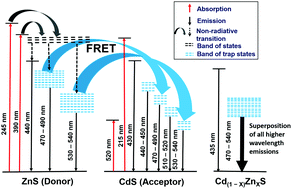Compositional variation dependent colour tuning and observation of Förster resonant energy transfer in Cd(1−x)ZnxS nanomaterials
Abstract
Evidence of composition dependent efficient Förster resonance energy transfer (FRET) between ZnS (donor) and CdS (acceptor) has been demonstrated in hexagonal ternary Cd(1−x)ZnxS nanomaterials synthesized by a chemical co-precipitation method. An agglomerated nanoparticulate morphology made of quantum dot like crystallites has been observed for all compositions. Analysis of the current–voltage characteristics of the samples reveals a gradual increase and then a decrease from a higher to a lower conductive state with the increase of the Zn content, displaying a variation from non-linear to linear characteristics. The tunability in the energy band gap has an increasing trend with the increase in the Zn/Cd ratio in Cd(1−x)ZnxS. The tunable emission varies from the green to the violet region with their intensity maxima increasing with the increase in Zn concentration. Significant spectral overlap between the absorbance spectrum of CdS and the photoluminescence spectrum of ZnS indicates FRET in Cd(1−x)ZnxS. The calculated energy transfer efficiencies vary from 65.7% to 89%, the Förster distances are confined within the range 11.13–14.77 Å and the inter donor–acceptor distances are limited to 14.29–71.4 Å. To get insight, electroluminescent efficiencies have been calculated using a theoretical model if Cd(1−x)ZnxS is used as emissive materials in LED devices. Cd0.5Zn0.5S nanomaterials have shown maximum external electroluminescence efficiency at low operating voltage. Hence, the FRET based tunable photoluminescence coupled with the observed electrical properties of Cd(1−x)ZnxS shows remarkable promise for their application in optoelectronic devices.



 Please wait while we load your content...
Please wait while we load your content...